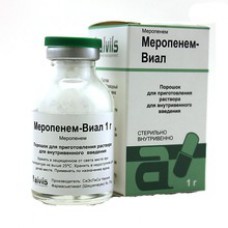Expiration date: 05/2026
Pharmacological action
Antibiotics group carbapenems. More stable relative to dehydropeptidase I than imipenem. It has a bactericidal effect by violating the synthesis of the cell wall of bacteria. Has an affinity for proteins binding penicillin (PBPs). Active against most aerobic and anaerobic gram-positive and gram-negative bacteria.
The event is resistant Xanthomonas maltophilia, Enterococcus faecium, methicillin-resistant strains of Staphylococcus spp.
Resistant to ?-lactamase.
Pharmacokinetics
After the on/in or/m introduction penetrates well into most tissues and body fluids (including cerebrospinal fluid from patients with meningitis). Is metabolized to a single inactive metabolite. T1/2 the on/in the introduction of 1 hour, when the/m introduction - 1.5 hours
Indications
For/in the introduction: treatment of infectious and inflammatory diseases heavy currents, caused by one or more Meropenem-sensitive pathogens: pneumonia, including hospital pneumonias, urinary tract infections, abdominal cavity, pelvic organs (including endometritis), skin and soft tissue, meningitis, septicaemia, suspected bacterial infection with febrile episodes on the background of neutropenia (empirical treatment).
For the on/m introduction: bacterial exacerbation of chronic bronchitis, uncomplicated urinary tract infections.
Dosage regimen
In / in adults, a single dose varies from 500 mg to 2 g, the frequency of administration and duration of treatment are set individually, depending on the indications and severity of the disease. Children with body weight less than 50 kg 10-12 mg/kg every 8 h in children weighing more than 50 kg used doses intended for adults.
In/m, adults - 500 mg every 8 hours, in elderly patients 500 mg every 12 h
Side effect
From the digestive system: abdominal pain, nausea, vomiting, diarrhea, reversible increase in bilirubin, transaminases, schf and LDG.
From the blood clotting system: reversible thrombocytopenia, eosinophilia, neutropenia.
Allergic reactions: itching, rash, urticaria.
From the nervous system: headache, paresthesia.
The effects caused by chemotherapeutic action: oral candidiasis, vaginal candidiasis, pseudomembranous colitis.
Local reactions: inflammation, thrombophlebitis, pain at the injection site.
Other: in some cases, a positive direct or indirect sample of Coombs.
Contraindications
Hypersensitivity to Meropenem and other products of the carbapenem group.
Application during pregnancy and breast-feeding
During pregnancy and lactation (breastfeeding), use is possible only in cases where the expected benefit of therapy for the mother exceeds the possible risk for the fetus or child.
In experimental studies it is shown that Meropenem is excreted in breast milk.
Application for violations of liver function
With caution, prescribe Meropenem for liver diseases-treatment should be carried out under the control of transaminases and bilirubin.
Application for violations of renal function
In violations of kidney function requires correction dosing regimen, depending on the values of CC.
Use in children
Not recommended for use in children under 3 months of age.
Special instruction
With caution, assign Meropenem liver diseases, diseases of the lower respiratory tract caused by Pseudomonas aeruginosa.
In violations of kidney function requires correction dosing regimen, depending on the values of CC. In liver disease treatment should be carried out under the control of transaminases and bilirubin.
With a history of hypersensitivity reactions to penicillins, carbapenem or other beta-lactam antibiotics, it is possible to develop hypersensitivity reactions to the event. As with other antibiotics, against the background of treatment with Meropenem, the probability of developing pseudomembranous colitis should be borne in mind.
With caution, Meropenem is used in combination therapy with drugs that have a nephrotoxic effect.
Not recommended for use in children under 3 months of age.
Drug interaction
Probenecid competes with Meropenem for active tubular secretion and thus inhibits the renal excretion of Meropenem, increasing its half-life and concentration in blood plasma (concurrent use is not recommended).


